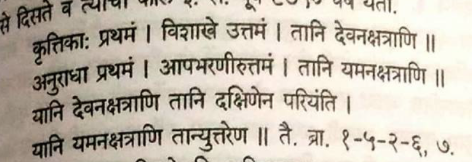We come across many astronomy incidents and knowledge in Ṛg-veda, and it never stops astonishing me either. In Ṛg-veda-8.96.9 I came across “Asura adevā“, which gives a notion of opposites ( in nature, position etc).
"Asura adevā"-Ṛg-veda-8.96.9
Yet another synonym which Halayudha Kosha has recorded- “Asura pūrvedevāḥ” which appears to say that initially the Asuras were called Devas.
"Asura pūrvedevāḥ"-Halāyudha Kosha
Likewise, we come across churning of ocean and the divide between Asura and Deva in PurANas. Similar contesting is recorded in Śatapatha Brāhmaṇa also–that the Gods and Asuras, both sprung from PrajApati, were contesting (Ś. Br. 3-5-4-2).
The Gods and Asuras, both sprung from Prajāpati, were contesting (Ś. Br. 3-5-4-2).
The problem
Now, that we have gathered lots of information on connection of Agni-Gharma-Taapas-Heat in northern hemisphere which is associated with Sun in northern hemisphere and is not at all associated with the northern course of sun from Winter solstice, rather I also connected it with the year beginning. Lets understand how the memory of season’s went to Asuras has been recorded in our texts. The problem is of understanding a phrase from Taittiriya Brāhmaṇa where it records devanakṣatrāṇi dakṣiṇena pariyanti. Late Shri PV Vartaka takes this from Taittiriya Brāhmaṇa text, although I couldn’t see this in my hard copy version of Taittiriya Brāhmaṇa in 1-5-2-6,7 but in 1-5-2-9. Also, I found this in Vaikhanasgrihyasutram.

Shri Vartaka assigns this above mentioned phrase ( see pic 1.) from Taittiriya Brāhmaṇa text, although I couldn’t cite this in my hard copy version of Taittiriya Brāhmaṇa. But I found this in Vaikhanasgrihyasutram also. If it were only ‘Kṛtikāḥ prathamam । viśākhe uttamam । tāni devanakṣatrāṇi । anūrādhāḥ prathamam। apabharaṇī rutamam । tāni yamanakṣatrāṇi ।” then also being the mouth of the year would get its observation from vernal equinox day (1430 BCE). But the next lines are intriguing, i.e., yāni deva nakṣatrāṇi dakṣiṇena pariyaṃti. PV vartaka has understood deva nakshatras to be on northern course due to “deva” word and thus he cited Kṛtikāḥ on winter-solstice point for the sake of deva nakṣatrāṇi and placed it at 8360 BCE. The problem of placing Krittika on cardinal points thus remains due to non attendance to the meaning of yāni deva nakṣatrāṇi dakṣiṇena pariyaṃti..
'कृतिकाः प्रथमम् । विशाखे उत्तमम् । तानि देवनक्षत्राणि । अनूराधाः प्रथमम्। अपभरणी रुतमम् । तानि यमनक्षत्राणि 'इत्यारभ्य ‘तेषु कुर्वीत यत्कारी स्यात् । पुण्याह एव कुरुते ' इति देवनक्षत्राणामादिभूतत्वात् अग्देिवत्यत्वात् 'मुखं वा एतन्नक्षत्राणाम् यत्कृतिकाः' इति श्रुतेश्च कृत्तिकादीनीत्युक्तम् । पातिक्रत्य सिद्धयर्थ अरुन्धतीदर्शनम् । स्थैर्यादिसिद्धार्थ ध्रुवदर्शनम् । मनोझं तया सह संभाप्य ।। ७ ।।--श्रीवैखानसगृह्यसूत्रम्-भागः १ विखनोमुनिः १९९७
However, the next line devanakṣatrāṇi dakṣiṇena pariyanti would have meant by Sun’s southern course , i.e., from summer solstice point if we go by common man’s and Suryasiddhanta’s understanding on sun’s coursing. While I find both the conjectures failing considerably since the Vedic Ayan, we discussed in many previous blogs, began from either Vasanta-spring season or Vasanta-sampāta-spring equinox.
Solution to the problem
The solution to the problem lies with the above evidence of Halāyudha kosha Asura pūrvedevāḥ, that means Asuras were earlier known as Devas.
In Taittiriya Brāhmaṇa 1.1.3.3 we find the phrase that Agni disappeared from gods (devaḥ)(1). He transformed himself into rat and entered the earth (2). Making holes [in the earth] he began to wander inside the earth (3). Then earth became full of rat-holes (4). the holes made by the rat become appropriate for the stay of gods (5). It became the hiding place of gods (6). That was adopted by gods. This simply means that the assigned godlike asterisms went hiding while Asuras were seen. At one point of time all the assigned Asuras only were seen during the night of vernal equinox day and all the Devas would go hiding beneath the earth, i.e., they would not be seen from sunset to sunrise time.
How to apply this information on Kṛtikāḥ?
Kṛtikāḥ will be seen at autumnal cardinal point to experience southern course of sun from equator. We will have to take the aadi point of Kṛtikāḥ so that we get Viśākhāḥ at the opposite side. From Kṛtikāḥ to Viśākhāḥ the sun’s course is in the southern hemisphere. Thus, Kṛtikāḥ was experiencing autumnal equinox during 14300 BCE. And this is how the beginning of the seasons went to Asuras.